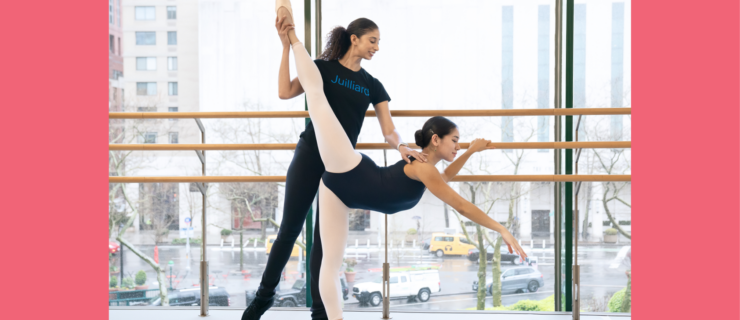Master Hops on Pointe: Karin Ellis-Wentz Demystifies One of Ballet's Trickiest Steps
“Hopping on pointe is a bit of a weird feeling,” says Karin Ellis-Wentz, head of pre-professional programs at the Joffrey Academy of Dance in Chicago. But, she adds, it’s a skill advanced dancers need “because it’s in so many variations.” Here, she takes us through the techniques and exercises that help her students master this necessary trick.
The “Ginch”
Before you can hop on pointe, says Karin Ellis- Wentz, “you have to find that ‘ginched’ position of the foot. Be fully on your box, and then plié without going over your shoe or pulling back off.” It takes some experimentation to find that “just right” placement of the foot and ankle. “Especially if you have flexible arches or feet that aren’t naturally strong, you may have to do extra practice and strengthening.”
 Elliana Teuscher. Courtesy The Joffrey Ballet
Elliana Teuscher. Courtesy The Joffrey Ballet
How Deep, How High?
The plié for hops on pointe should be quite shallow, especially when done on one leg. Generally, the jump itself is not high enough for the knees to stretch in the air. But stay very lifted and lengthened through the body, Ellis-Wentz says, “so you’re not pounding into that foot.”
The Body Position
Once her students are hopping in the center, the most common issue Ellis-Wentz sees is with their alignment. “They don’t keep their hips placed over their ankle and the box of the shoe. Are you too far back? Are you too far over?” The former tends to happen with hops in arabesque or attitude derrière; the latter when the hips get ahead of you in traveling hops, for instance with ballonnés or ronds de jambe. Both will knock you off your toes.
 Elliana Teuscher demonstrates practicing simple pliés on pointe to find the proper foot position. Courtesy The Joffrey Ballet
Elliana Teuscher demonstrates practicing simple pliés on pointe to find the proper foot position. Courtesy The Joffrey Ballet
Supplementary Exercises
“Do all your TheraBand and doming exercises so the intrinsic muscles in your feet are strong,” says Ellis-Wentz. She also recommends targeting important supportive muscles higher in the body: clamshells for your glutes, wall sits or lunges for your quads (and, since hops on pointe are hard on the quads, make sure to stretch them, too), and planks to solidify your core. She also stresses the importance of calf rises facing the barre: “On one foot in parallel, lightly holding the barre, slowly rise up almost to your complete relevé. Then slowly lower the heel but barely put any weight on it. Build up to 32.” Repeat this in plié, keeping the standing knee bent as you raise and lower the heel, to work a different muscle set.
The Right Shoe
“You can’t hop when your shoes are too soft—or too hard!” Ellis-Wentz notes that shoes with tips that are angled to allow you to be farther over your box may make hopping difficult. Whether this is the issue or not, she says, “if you’re really having a hard time, it might be worth investigating if a different shoe has a better platform for you to hop on.”
 Ellis-Wentz and Teuscher. Courtesy The Joffrey Ballet
Ellis-Wentz and Teuscher. Courtesy The Joffrey Ballet
Extra Tips
1. Ellis-Wentz gives a simple exercise to help her students find the correct position and begin building strength. At the barre, spring up to sous-sus, plié on pointe, stretch and repeat. “The student can also just bounce in that plié first, then progress to hopping. When you get stronger, do that on one foot as well, in different positions.”
2. “I like to use the image of a pogo stick, bouncing up and down,” says Ellis-Wentz. “Keep your skeleton stacked straight over the base—shoulder, rib, hip and knee aligned—or you just go bouncing off.”





